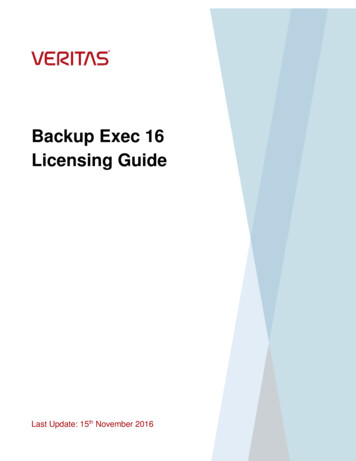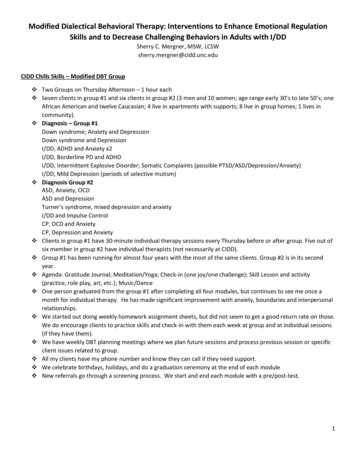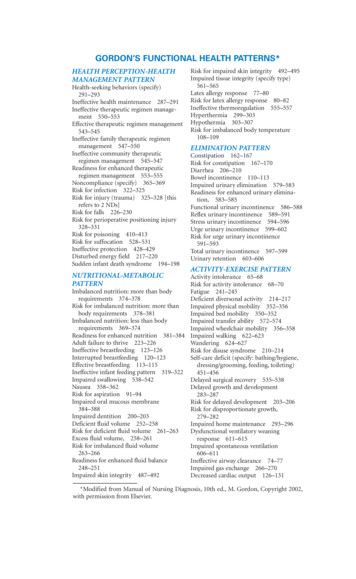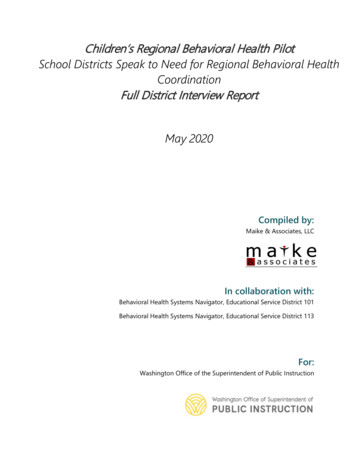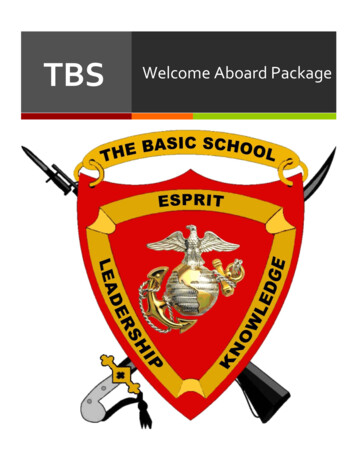
Transcription
California Department of Mental HealthTHERAPEUTIC BEHAVIORAL SERVICES (TBS)DOCUMENTATION MANUALByCalifornia State Department of Mental HealthOctober 2009Version 2.0
CODE 58 – Therapeutic Behavioral Services (TBS)ChapterTABLE OF cknowledgements4552Therapeutic Behavioral Services (TBS)Definition: Therapeutic Behavioral Services (TBS)Medical Necessity CriteriaTBS Class Criteria6689Documentation Standards10TBS Assessment Documentation12TBS Plans of Care/Client Plans13TBS Assessment and Plans with Other IntensiveServices16TBS Assessments and Plans to Support LowerLevel of Care1630 – Day Unplanned TBS Contact Documentation17TBS Assessment and Planning:- Psychiatric Inpatient Unit,- Inpatient Unit at a Psychiatric Health Facility (PHF)- Institute for Mental Disease (IMD) for Transition toa Lower Level of Care Utilizing TBS17TBS Progress Notes and Documentation183TBS Service Function Code 584California Department of Mental Health (DMH)1921Services NOT Allowable2
CODE 58 – Therapeutic Behavioral Services S Assessment/Eligibility FlowchartMEDICAL NECESSITY CRITERIATBS Assessment/Eligibility ChecklistReimbursement Requirements for TBS Contract and SiteRequirements32Non-Reimbursable Services/Activities: Trends recorded by DMHFactors to consider: Common Causes for Disallowance andPossible SolutionsLock-outs (TBS)Reasons for RecoupmentInformation and WebsitesCode ReferencesExample Progress Notes32343536363740What is Service Function Code (SFC) 58?All direct and indirect TBS services should be recorded as Mode 15, ServiceFunction Code (SFC) 58. For more information about Code 58 and which TBSactivities should be recorded as Code 58, please refer to page 19 of thedocumentation manual.Found throughout the documentation manual, this symbol is intended todraw attention to important information regarding TBS assessment anddocumentation.California Department of Mental Health (DMH)3
CODE 58 – Therapeutic Behavioral Services (TBS)CHAPTER 1ForwardTo bring the Emily Q. v Bonta case to a successful conclusion, the Federal Court in LosAngeles appointed a Special Master to ensure that the members of the certified Emily QClass have increased access to and utilization of Therapeutic Behavioral Services(TBS).The Special Master and the Emily Q Settlement Team worked collaboratively in thedevelopment of the court approved plan. This Settlement Team consists of theDepartment of Mental Health (DMH) and California Department of Health Care Services(DHCS) staff, defendant’s and plaintiffs’ counsels, a local mental health plan director, amental health director’s association executive, a private sector TBS provider, and afamily/youth representative. Together, this Settlement Team developed a “Nine-PointPlan” to increase access and utilization to TBS. The Court issued an order approvingthe Nine-Point Plan on November 14, 2008.To support the implementation of the Nine-Point Plan, the DMH issued InformationNotices 08-38, 09-10, a TBS specific webpage and the creation of the TBSAccountability Communications and Training (TACT) committee.Point 9 of the Nine-Point Plan (Exit Strategy) explicitly states that each MHP has theresponsibility to “demonstrate their ability to accurately employ procedure codes, costreports and CSI data reporting for TBS services.” This TBS documentation manual willbe instrumental in helping MHPs and TBS providers meet the Court’s expectations ofsuccess in providing and documenting TBS.Implementation of the Nine-Point Plan began in January 2009 with the issuance ofInformation Notice 08-38. This comprehensive plan requires that DMH produce twotechnical assistance manuals: one on TBS best practices and one on chartdocumentation. Settlement Team members determined that the TBS documentationmanual was a critical element in increasing access to and utilization of TBS for classmembers. DMH contracted with the California Institute for Mental Health (CiMH) toassist in the development of the training and technical assistance components of thePlan. This document is a result of the collaborative work among the parties involved inCalifornia Department of Mental Health (DMH)4
CODE 58 – Therapeutic Behavioral Services (TBS)the Emily Q Settlement process.IntroductionThis TBS Documentation manual is supplemental to the Early and Periodic ScreeningDiagnosis and Treatment (EPSDT) Chart Documentation Manual and replaces the TBSsection of that manual. This documentation manual is intended to instructcounties/provider-agencies on how to document and claim Medi-Cal appropriately whenproviding TBS. It will also serve as a training tool for DMH Program Compliance staffand their audit contractors to assist local agencies and their contract providers.In all cases, the reader should defer to California Code of Regulations (CCR), Title 9;Federal requirements; Mental Health Plan (MHP) contractual requirements, andapplicable MHP policies and procedures. The MHP has the authority to administer andauthorize services according to program and organizational needs that may requireadditional standards and other requirements that are not covered in this manual.(Welfare & Institution Code §14680 - §14684).*NOTE: Point 1 of the Nine Point Plan significantly reduces and streamlinesadministrative requirements that may have been barriers to TBS access andutilization. For a complete list of these changes please refer to DMH InformationNotice 08-38 at:http://www.dmh.ca.gov/DMHDocs/2008 Notices.asp.Included with this documentation manual are Appendices 1-5 that provide informationon the provision of TBS that may assist MHPs in meeting their responsibilities under theCourt’s approved Exit Strategy.This Documentation Manual will be maintained by DMH and reviewed and updated asneeded. The most recent version of this document can be found on the DMH webpageat http://www.dmh.ca.gov/Services and Programs/Children and Youth/EPSDT.aspAcknowledgementsDMH would like to acknowledge the following groups and organizations for theirdedication and efforts resulting in this documentation manual:California Department of Mental Health (DMH)5
CODE 58 – Therapeutic Behavioral Services (TBS)The Emily Q Settlement TeamThe TBS Accountability, Communications, and Training (TACT) TeamCalifornia Institute of Mental HealthCHAPTER 2 - THERAPEUTIC BEHAVIORAL SERVICES (TBS)Therapeutic Behavioral Services (TBS)DefinitionTherapeutic Behavioral Services (TBS) are supplemental specialty mental healthservices covered under the Early and Periodic Screening, Diagnosis and Treatment(EPSDT) benefit. Title 9, California Code of Regulations (CCR), Section 1810.215states, “EPSDT supplemental specialty mental health services” means those servicesdefined in Title 22, [CCR] Section 51184, that are “provided to correct or ameliorate thediagnoses listed in Section 1830.205, and that are not otherwise covered by thischapter."TBS is an intensive, individualized, one-to-one behavioral mental health serviceavailable to children/youth with serious emotional challenges and their families, who areunder 21 years old and have full-scope Medi-Cal. TBS is never a primary therapeuticintervention; it is always used in conjunction with a primary specialty mental healthservice. TBS is available for children/youth who are being considered for placement inan RCL 12 or above (whether or not an RCL 12 or above placement is available) or whomeet the requirements of at risk of hospitalization in an acute care psychiatric facility(whether or not the psychiatric facility is available). TBS is designed to helpchildren/youth and their parents/caregivers (when available) manage these behaviorsutilizing short-term, measurable goals based on the child’ and family’s needs.A "Specialty Mental Health Service" must be one of the following as defined byCalifornia Code of Regulations:(a) Rehabilitative Mental Health Services, including:(1) Mental health services;(2) Medication support services;(3) Day treatment intensive;California Department of Mental Health (DMH)6
CODE 58 – Therapeutic Behavioral Services (TBS)(4) Day rehabilitation;(5) Crisis intervention;(6) Crisis stabilization;(7) Adult residential treatment services;(8) Crisis residential treatment services;(9) Psychiatric health facility services;(b) Psychiatric Inpatient Hospital Services;(c) Targeted Case Management*;(d) Psychiatrist Services;(e) Psychologist Services;(f) EPSDT Supplemental Specialty Mental Health Services; and(g) Psychiatric Nursing Facility Services.*NOTE: Targeted Case Management is recognized as a Specialty Mental HealthService. Targeted Case Management is defined as services that assist a beneficiary toaccess needed medical, educational, social, prevocational, vocational, rehabilitative, orother community services. The service activities may include, but are not limited to,communication, coordination, and referral; monitoring service delivery to ensurebeneficiary access to service and the service delivery system; monitoring of thebeneficiary's progress; placement services; and plan development.TBS in conjunction with a Specialty Mental Health Service can help children/youth andparents/caregivers, foster parents, group home staff, and school staff or others to learnnew ways of reducing and managing challenging behaviors as well as strategies andskills to increase the kinds of behavior that will allow children/youth to be successful intheir current environment.TBS can be provided anywhere in the community: at home, school, other places suchas after-school programs and organized recreation program, except during lock-outs(see appendix 7).*NOTE: TBS is not appropriate for “suicide watch” consisting solely of supervision.California Department of Mental Health (DMH)7
CODE 58 – Therapeutic Behavioral Services (TBS)ELIGIBILITYEligibility for TBS Services is based on Medical Necessity and Class Certification. Eachof the required criteria must be supported and substantiated by documentation.*Appendix 1 includes a “TBS Assessment/Eligibility Flowchart.” The TBSAssessment/Eligibility Flowchart will aid the clinician/organization in determining theclinical appropriateness and need for TBS services.Establishing Medical NecessityMedical necessity criteria must be met for reimbursement of specialty mental healthservices through the Medi-Cal Program. For medical necessity to be met there must firstbe a diagnosis identified in the California Code of Regulations (CCR), Title 9, Chapter11, 1830.205 (see Appendix 2). A detailed description of these diagnoses may be foundin the Diagnostic and Statistical Manual of Mental Disorders, (DSM), published by theAmerican Psychiatric Association. In addition for medical necessity to be met theremust be impairment as a result of the mental disorder, an intervention that addressesthe impairment, and there must be an expectation that the intervention wouldsignificantly diminish the impairment or prevent deterioration, or allow for individuallyappropriate developmental progress (see Appendix 2).Specific criteria for medical necessity for MHP specialty mental health servicesreimbursement for eligible beneficiaries under 21 years of age are identified in CCR,Title 9, Chapter 11, 1830.210 (see Appendix 2).All components of the medical necessity criteria stated above must be met and clearlydocumented in the record for reimbursement through the Medi-Cal Program.California Department of Mental Health (DMH)8
CODE 58 – Therapeutic Behavioral Services (TBS)TBS Class CriteriaIn addition to meeting medical necessity criteria, TBS recipients must also meet “classcriteria.” The class criteria defines a certified class of children and youth who areeligible for TBS services. The following is a description of the certified class. Child/Youth is placed in a group home facility of RCL 12 or above or in alocked treatment facility for the treatment of mental health needs; orChild/Youth is being considered by the county for placement in a facilitydescribed above; orChild/Youth has undergone at least one emergency psychiatrichospitalization related to his/her current presenting mental health diagnosiswithin the preceding 24 months; orChild/Youth has previously received TBS while a member of the certifiedclass; orChild/Youth is at risk of psychiatric hospitalization.A child/youth meets the requirements of “at risk of” hospitalization in an acute carepsychiatric facility when hospitalization is one option (not necessarily the only option)being considered as part of a set of possible solutions to address the child’s needs.Additionally, a child meets the requirements when his or her behavior could result inhospitalization in such a facility if the facility were actually available, regardless ofwhether an inpatient psychiatric facility is available.A child/youth meets the requirements of “being considered for” placement in an RCL12 or above when an RCL 12 or above placement is one option (not necessarily theonly option) that is being considered as part of a set of possible solutions to address thechild’s needs. In addition, a child meets the requirements when his or her behaviorcould result in placement in such a facility if the facility were actually available,regardless of whether an RCL 12 or above placement is available.California Department of Mental Health (DMH)9
CODE 58 – Therapeutic Behavioral Services (TBS)CHAPTER 3 - DOCUMENTATION STANDARDSTBS AssessmentsDocumentation standards for client care are identified in the contract between DMH andthe MHP. These are the minimum standards to support Medi-Cal claims for the deliveryof services. All of the standards must be addressed in the client record; however, thereis no requirement that the records have a specific document or section addressingthese topics. For children/youth or certain other clients unable to give a history, thisinformation may be obtained from parents/caregivers. The TBS Assessment shouldestablish Medical Necessity for TBS by evaluating the child/youth’s current behavior(presenting problem/impairment) and documenting the following:(1) How the behavior causes a significant impairment in an important area of lifefunctioning,(2) A reasonable probability of significant deterioration in an important area of lifefunctioning without TBS services, or(3) A reasonable probability that the child/youth would not progress developmentally asindividually appropriate without TBS services.The following elements are required documentation components in order tosubstantiate medical necessity for mental health services. TBS assessments can beseparate, or part of a more comprehensive assessment.o Presenting problem: Documentation of the client’s chief behavioralimpairment, history of the presenting problem(s), including current level offunctioning, and current family information including relevant familyhistory.o Psychological Factors: Documentation of relevant conditions andpsychosocial factors affecting the client’s physical health and mentalhealth, including living situation, educational/vocational situation, dailyCalifornia Department of Mental Health (DMH)10
CODE 58 – Therapeutic Behavioral Services (TBS)activities, social support, cultural and linguistic factors, and history oftrauma.o Mental Health History: Documentation of mental health history andprevious mental health treatment: providers, therapeutic modality, (e.g.,medications, psychosocial treatments) and response. If possible, includeinformation from other sources of clinical data, such as previous mentalhealth records, and relevant psychological testing or consultation reports.o Medical History: Documentation of the complete, relevant medical historyand physical health conditions reported by the child/youth orparent/caregiver. Include the name, address and current phone numberof current source of medical treatment. Note: All appropriate Releases of Information forms should becompleted prior to communication with other treatment providers.o Prenatal: Documentation of the prenatal and perinatal events andrelevant/significant developmental history. If possible, include othermedical information from medical records or relevant consultation reports.o Medication: Documentation about medications the client has received or isreceiving to treat medical conditions, including duration of medicaltreatment. Documentation of allergies or adverse reactions to medications,etc.o Substance exposure/Substance use: Documentation of past and presentuse of tobacco, alcohol, caffeine, CAM (complementary and alternativemedications), over–the–counter, and illicit drugs.o Strengths: Documentation of client strengths that may be utilized instrategies for achieving client treatment plan goals.o Risks: Documentation of special status situations that present a risk toclient or others, including past or current trauma.California Department of Mental Health (DMH)11
CODE 58 – Therapeutic Behavioral Services (TBS)o Mental status examinationo Diagnosis: A complete five-axis diagnosis from the most current DSM, or adiagnosis from the most current ICD-9 code shall be documented,consistent with the presenting problems, history, mental statusexamination and/or other clinical data.o Any additional relevant clarifying formulation information.TBS Assessment DocumentationIn addition to the minimum components listed above, the TBS assessmentmust identify the following: Medical Necessity: Documentation must be comprehensive enough to identifythat the child or youth meets the medical necessity criteria specifically for theprovision of TBS services. Medi-Cal Eligibility: Documentation must state that the child/youth is a full-scopeMedi-Cal beneficiary under 21 years of age. Member Eligibility: Documentation must note that the child/youth is a member ofthe certified class; that the child/youth is receiving other specialty mental healthservices; and that the child or youth has specific behaviors that require TBS. Targeted Behavior(s): Documentation must identify the specific behaviors thatjeopardize continuation of the current residential placement or put the child at riskfor psychiatric hospitalization or the specific behaviors that are expected tointerfere with a plan to transition to a lower level of residential placement.California Department of Mental Health (DMH)12
CODE 58 – Therapeutic Behavioral Services (TBS) Clinical Judgment: Documentation must include sufficient clinical information todemonstrate that TBS is necessary to sustain the residential placement, or tosuccessfully transition to a lower level of residential placement; and that TBS canbe expected to provide a level of intervention necessary to stabilize thechild/youth in the existing placement. Behavior Modification: Documentation should identify observable andmeasureable changes and indicate when TBS services have been successfuland could be reduced or terminated. Adaptive Behaviors: Documentation should note identified skills and positiveadaptive behaviors that the child/youth uses to manage the problem behaviorand/or uses in other circumstances that could replace the specified problembehaviors.Initial and on-going TBS assessments may be included as part of an overallassessment of a child or youth’s mental health needs or may be a separate documentspecifically establishing whether initial/ongoing TBS is needed.TBS Plans of Care/Client PlansTBS client plans can be either separate plans or part of a more comprehensive plan.The TBS client plan provides clinical direction for short-term intervention(s) to addressspecific behaviors of the child/youth that were identified in the TBS assessment.Interventions that directly address the behaviors identified during the assessmentprocess are the key component necessary to developing an effective TBS client plan.Interventions may be modified over time based on the degree of effectiveness of theintervention strategy and the child/youth’s changing behaviors and needs.TBS client plans provide a detailed description of the treatment including behaviormodification strategies for the child/youth.California Department of Mental Health (DMH)13
CODE 58 – Therapeutic Behavioral Services (TBS)TBS client plans should document the following: Targeted Behaviors: Clearly identified specific behaviors that jeopardize theresidential placement or transition to a lower level of residential placement andthat will be the focus of TBS. Plan Goals: Specific, observable quantifiable goals tied to the targeted behaviors. Benchmarks: The objectives that are met as the child/youth progresses towardsachieving client plan goals. Interventions: Proposed intervention(s) that will significantly diminish the targetedbehaviors.o A specific plan of intervention for each of the targeted behaviors orsymptoms identified in the assessment and the client plan, which isdeveloped with the family/caregiver, if available, and as appropriate.o A specific description of the changes in the behaviors that theinterventions are intended to produce, including an estimated time framefor these changes.o A specific way to measure the effectiveness of the intervention at regularintervals and documentation of refining the intervention plan when theoriginal interventions are not achieving expected results. Transition Plan: A transition plan that describes the method the treatment teamwill use to decide how and when TBS will be decreased and ultimatelydiscontinued, either when the identified benchmarks have been reached or whenreasonable progress towards goals/benchmarks is not occurring and, in theclinical judgment of the treatment team developing the plan, are not reasonablyexpected to be achieved. This plan should address assistingparents/caregivers/school personnel with skills and strategies to providecontinuity of care when TBS is discontinued.California Department of Mental Health (DMH)14
CODE 58 – Therapeutic Behavioral Services (TBS) Transitional Age Youth (TAY): As necessary, includes a plan for transition toadult services when the beneficiary is no longer eligible for TBS and will needcontinued services. This plan addresses assisting parents/caregivers with skillsand strategies to provide continuity of care when this service is discontinued,when appropriate in the individual case.If the beneficiary is between 18 and 21 years of age, include notes regarding anyspecial considerations that should be taken into account. Signature: A signature (or electronic equivalent) of, at least, one of the following:o A clinician who developed the care plan or is providing the service(s)*o A clinician representing the MHP providing the service*If the above person providing the service is not licensed or waivered, a cosignature from a physician, licensed/waivered psychologist, licensed/registeredsocial worker, or a licensed or registered marriage and family therapist isrequired. Evidence of the child/youth’s degree of participation and agreement with theclient plan as evidenced by the child/youth’s or legal guardian’s signature. Ifchild/youth or legal guardian is unavailable or refuses to sign the client plan, awritten explanation in the progress notes why the signature could not beobtained. Evidence that a copy of the Client Plan was provided to the child/youth orparent/caregiver upon request.California Department of Mental Health (DMH)15
CODE 58 – Therapeutic Behavioral Services (TBS)*NOTE: TBS Client Plan updates should document the following: any significantchanges in the child or youth’s environment since the initial TBS Client Plan; and ifTBS interventions tried to-date have not been effective and the child/youth is notmaking progress as expected towards identified goals. In this situation, there mustbe documentation indicating that the provider has considered alternatives, and onlyrequested additional hours/days for TBS based on the documented expectation thatthe additional time will be effective. A TBS Client Plan update is an addendum to theinitial TBS Client Plan and is not a progress note.TBS Assessments and Plans With Other Intensive ServicesTBS assessments and services can be provided in conjunction with an intensiveprogram, such as Day Treatment or Residential Treatment; however, medical necessityfor TBS must be documented and should reflect that TBS is not being provided solelyfor the convenience of the Day Treatment or Residential Treatment program staff, thatTBS does not supplant existing program staff requirements, and that the staff providingTBS are not staff counted in the other program’s staffing ratios.*NOTE: Although TBS can be provided in a Day Treatment setting, TBS services canonly be claimed for the actual amount of time that the TBS coach spends activelyimplementing the TBS Plan. Additionally, the child/youth must be present in the daytreatment program for at least 50 percent of the time for the provider to claim the daytreatment day or half-day. If the child's behavior requires the TBS coach to intervene tothe extent that the child is unable to participate in the Day Treatment Program for aminimum of 50 percent of the day, Day Treatment hours cannot be claimed.TBS to support transition to Lower Level of CareTBS may be appropriate for transitioning a child/youth to a lower level of care (stepdown) from an inpatient or residential treatment setting when specific target behavior(s)or symptom(s) prevent, or can be expected to jeopardize, that step-down. Plannedinterventions must focus on the specific target behaviors identified in the assessment.California Department of Mental Health (DMH)16
CODE 58 – Therapeutic Behavioral Services (TBS)30 - Day Unplanned TBS Contact DocumentationThe MHP may conditionally authorize/approve the provision of TBS for a maximum of30 calendar days when class membership cannot be established for a child/youth. Thismay be done: Up to 30 days or until class membership is established, whichever comes first;and When the child/youth presents with urgent or emergency conditions thatjeopardize his/her current living arrangement.Documentation must include evidence that TBS was medically necessary and the mostappropriate level of service available to address the child/youth’s mental healthcondition.Inpatient TBS AssessmentsTBS Assessment and Planning While the Child/Youth is in a PsychiatricInpatient Unit, an Inpatient Unit at a Psychiatric Health Facility (PHF), an Institutefor Mental Disease (IMD), or Juvenile Detention Facility for Transition to a LowerLevel of Care Utilizing TBSAlthough a child/youth currently placed in an IMD, juvenile detention facility (unlessevidence that the court has ordered placement in a group home or other noninstitutional setting), or an acute inpatient facility is not eligible to receive TBS while inthese settings, TBS eligibility can be established and TBS can be planned. However,such planning activities are not Medi-Cal reimbursable, except upon the day ofadmission. In such cases, the MHP is responsible for determining and assuring there isdocumentation of: 1) the child/youth’s Medi-Cal eligibility upon discharge; and 2) thechild/youth’s eligibility for County Mental Health Plan (MHP) services upon discharge. Ifthe MHP determines that the child/youth is eligible for Medi-Cal services upon dischargeand that TBS are appropriate, the MHP must ensure that the services are availableupon discharge. See appendix 7 for more details.California Department of Mental Health (DMH)17
CODE 58 – Therapeutic Behavioral Services (TBS)*NOTE: TBS (code 58) is only reimbursable on days of admission to Crisis ResidentialTreatment Services, Inpatient Psychiatric Services or Psychiatric Health FacilityServices reimbursed by Medi-Cal.TBS Progress Note DocumentationTBS Progress notes should clearly document the occurrence of the specific behaviorsthat threaten the stability of the current placement or interfere with the transition to alower level of residential placement, and which are the result of the covered mentalhealth diagnosis, and the interventions provided to ameliorate thosebehaviors/symptoms.Progress Note GuidelinesFor the substantiation of all mental health services it is critical to maintaindocumentation that is clear, concise and succinct.All TBS Progress notes should include the following: DATE: The date of service must be documented for all services rendered. LEGIBILITY: Charting must be legible, including the legibility of provider’ssignature and professional credentialing. INTERVENTION: Each progress note must document key clinicaldecisions and interventions that are directed to the TBS goals of thechild/youth.- Documentation must reflect interventions that are consistent withthe TBS client plan.- Documentation must identify clinical interventions provided that areCalifornia Department of Mental Health (DMH)18
CODE 58 – Therapeutic Behavioral Services (TBS)-designed to change or eliminate maladaptive behaviors andincrease adaptive behaviors (not provided solely for theconvenience of the family or other caregivers, physician, teacher, orstaff).Documentation must focus on identified target behaviors.Documentation must identify child/youth’s receptivity/response tointerventions.TBS documentation should not address conditions that are not partof the identified child/youth’s mental health condition. SIGNATURE: A signature (or electronic equivalent) of the staff providingthe service, including their clinical license, professional degree, or job title(if staff member is licensed, clinical license, such as LCSW, MD, MFT,etc., must be included). TIMELINESS/FREQUENCY: Records should include a correspondingnote for every TBS service contact including, but not limited to:- Direct one-to-one TBS service- TBS Assessment and/or Reassessment- TBS Collateral contact (see CCR Title 9 Section 1810.206)- TBS Plan of Care/Client Plan or its documented review/updates*NOTE: Progress notes must include a comprehensive summary covering the
Department of Mental Health (DMH) and California Department of Health Care Services (DHCS) staff, defendant’s and plaintiffs’ counsels, a local mental health plan director, a mental health director’s association executive, a privat
